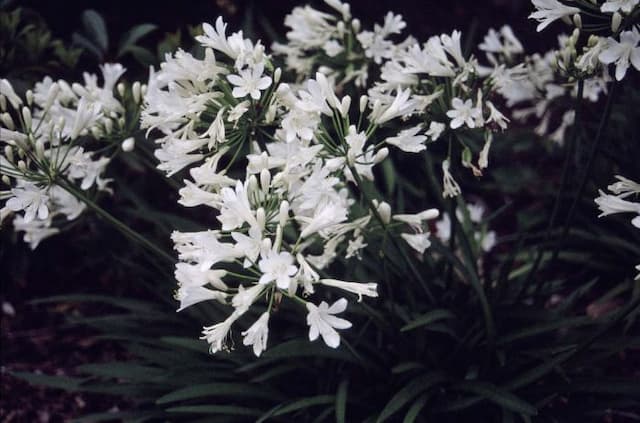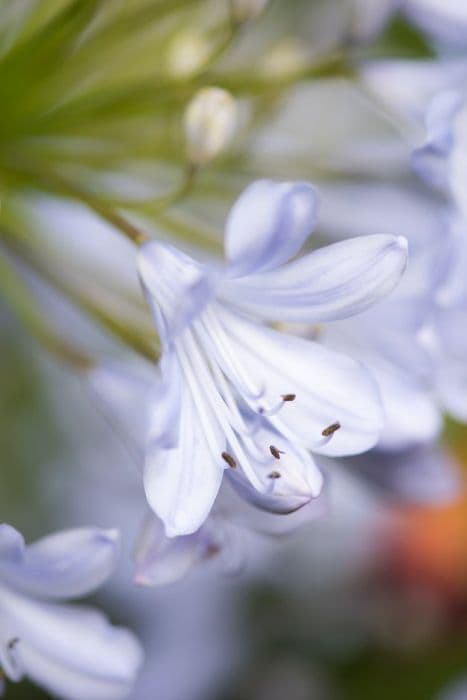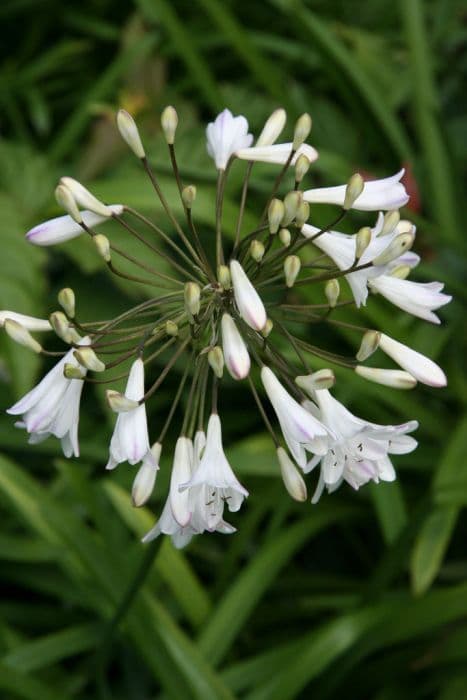Drooping Agapanthus Agapanthus inapertus subsp. pendulus

ABOUT
The plant known as drooping agapanthus is notable for its striking, pendulous floral displays. It forms clumps with long, slender leaves that arch gracefully. Such leaves are typically green, providing a lush appearance. The real allure of this plant lies in its captivating flowers. They bloom on long stalks, high above the foliage, and dangle downwards, which is quite distinctive and gives this plant its common name. Each flower stalk, or stem, culminates in a cluster of individual flowers. The blossoms themselves are a sight to behold – typically varying in shades of deep to midnight blue or sometimes violet. Each flower is tubular and flares out at the mouth, resembling little bells or funnels, creating an elegant and somewhat whimsical effect when bunched together. They breathe life into any garden space when in bloom, usually becoming the focal point with their eye-catching arrangement. The delicate arrangement of the flowers, paired with their pendulous nature, provides a soft yet dramatic visual that can captivate any observer.
About this plant
 Names
NamesSynonyms
Drooping Agapanthus, Weeping Agapanthus, Pendulous Agapanthus, Drakensberg Agapanthus, Swinging Agapanthus.
Common names
Agapanthus inapertus subsp. pendulus.
 Toxicity
ToxicityTo humans
The Agapanthus, commonly known as Lily of the Nile or African Lily, has components that can be toxic to humans when ingested. Consuming parts of this plant can potentially lead to symptoms such as nausea, vomiting, abdominal pain, and diarrhea. Skin contact with the sap may also cause irritation or dermatitis in sensitive individuals. It is generally advised to avoid eating any part of the Agapanthus to prevent these adverse health effects.
To pets
Lily of the Nile or African Lily is also toxic to pets, including dogs and cats. If a pet ingests parts of this plant, they may experience symptoms such as vomiting, diarrhea, abdominal pain, and excessive salivation. In some cases, ingestion can also lead to lethargy or other systemic effects. It is important to keep this plant out of reach of pets to prevent possible poisoning.
 Characteristics
CharacteristicsLife cycle
Perennials
Foliage type
Evergreen
Color of leaves
Green
Flower color
Blue
Height
3 feet [0.91 meters]
Spread
2 feet [0.61 meters]
Plant type
Bulb
Hardiness zones
8
Native area
South Africa
Benefits
 General Benefits
General Benefits- Aesthetic Appeal: Agapanthus inapertus subsp. pendulus, commonly known as Drooping Agapanthus, provides ornamental value with its striking blue or violet flowers which add visual interest to gardens.
- Low Maintenance: Drooping Agapanthus requires minimal care once established, making it a convenient choice for gardeners seeking attractive yet easy-to-maintain plants.
- Drought Tolerance: This plant is relatively drought-tolerant, making it suitable for xeriscaping and reducing the need for frequent watering.
- Erosion Control: The root system of Drooping Agapanthus can help to stabilize soil and prevent erosion on slopes or in areas prone to soil degradation.
- Attracts Wildlife: The flowers of the Drooping Agapanthus can attract pollinators such as bees and butterflies, promoting biodiversity in the garden.
- Border and Edge Definition: The structured growth pattern of Drooping Agapanthus makes it ideal for defining borders and edges in landscape design.
- Versatility: This plant can be used in a variety of garden styles, including formal, cottage, and coastal gardens, due to its versatile nature and attractive appearance.
- Container Gardening: Drooping Agapanthus is suitable for container gardening, allowing it to be featured on patios, balconies, or as an accent in smaller spaces.
 Medical Properties
Medical PropertiesThis plant is not used for medical purposes.
 Air-purifying Qualities
Air-purifying QualitiesThis plant is not specifically known for air purifying qualities.
 Other Uses
Other Uses- Agapanthus (common name) stalks can be used as natural weaving materials for baskets and mats due to their strength and flexibility when dried.
- The seeds from Agapanthus can be used in jewelry making, as they have an attractive shape and can be drilled to create beads.
- The sap from the Agapanthus plant has been traditionally used as an ingredient in adhesives and glues.
- The large leaves of the Agapanthus can be used as natural wrappers or coverings for food in outdoor cooking practices.
- Due to their architectural appearance, Agapanthus plants are used as focal points in contemporary garden design.
- Dried Agapanthus flowers can be used in potpourri mixes to add volume and a unique texture.
- Agapanthus can be used in art projects, such as natural dyes for fabrics, inspired by their vibrant blue and purple hues.
- The plant's fibrous roots may be used to create sustainable packaging materials or eco-friendly disposables with further research and development.
- Agapanthus flowers and leaves can serve as a food source for some species of butterflies and hummingbirds, thus they can be used to attract wildlife in garden settings.
- By planting Agapanthus in areas prone to soil erosion, their root systems can help stabilize the soil and prevent further degradation.
Interesting Facts
 Feng Shui
Feng ShuiThe Agapanthus is not used in Feng Shui practice.
 Zodiac Sign Compitability
Zodiac Sign CompitabilityThe Agapanthus is not used in astrology practice.
 Plant Symbolism
Plant Symbolism- Love Letters: The Agapanthus is sometimes referred to as the "Love Flower" and is believed to symbolize love and fertility. Its name is derived from the Greek words 'agape' (love) and 'anthos' (flower), suggesting the bearing of love and affection.
- Beauty: With its striking blue to purple flowers, Agapanthus represents beauty and a fine appearance, often used in gardens and floral arrangements for its aesthetic appeal.
- Endurance: As a hardy perennial that can survive in diverse conditions, Agapanthus signifies strength, survival, and resilience in facing challenges.
- Home: It is often associated with the hearth or a happy home, making it a popular plant in domestic gardens and a welcome gift to signify warmth and domesticity.
 Water
WaterThe Agapanthus, commonly known as African Lily, should be watered deeply once a week, ensuring that water reaches the roots. During the growing season, in the absence of rainfall, increase watering to twice a week. Provide about one gallon of water per plant for each watering session, but adjust this amount depending on the size of the plant and the weather conditions. It's crucial to let the soil dry out slightly between waterings to prevent root rot. In winter, when the plant is dormant, reduce watering significantly to match the plant's reduced water needs.
 Light
LightAfrican Lilies thrive best in full sun to partial shade. They should be positioned where they can receive at least six hours of sunlight daily. However, if you're in a region with intensely hot summers, providing some afternoon shade can help to prevent scorching the leaves.
 Temperature
TemperatureAfrican Lilies prefer a temperature range between 50°F and 80°F and can survive short periods down to 30°F, although prolonged exposure to freezing temperatures can damage or kill the plant. They grow best in areas with warm days and cooler nights, and should be protected from harsh winter cold.
 Pruning
PruningPrune African Lilies to remove spent flower stalks and promote a tidy appearance; this can be done immediately after the flowers fade. Additionally, every few years in early spring, cut back the entire plant by about one-third to rejuvenate and encourage bushier growth. Pruning is also the time to divide clumps if the plant has become too crowded.
 Cleaning
CleaningAs needed
 Soil
SoilThe best soil mix for Agapanthus, commonly known as African Lily, is a well-draining, loamy or sandy soil. Incorporate compost or a balanced slow-release fertilizer to provide nutrients. The pH should ideally be slightly acidic to neutral, between 6.0 and 7.0.
 Repotting
RepottingAfrican Lilies should be repotted every 2 to 3 years to refresh the soil and accommodate root growth. It's best to repot in the spring before the growing season begins.
 Humidity & Misting
Humidity & MistingAfrican Lily prefers moderate humidity levels. It does not require high humidity to thrive; average room humidity is generally sufficient.
 Suitable locations
Suitable locationsIndoor
Place African Lily near a sunny window and water moderately.
Outdoor
Plant in partial sun, protect from harsh elements, water well.
Hardiness zone
8-10 USDA
 Life cycle
Life cycleAgapanthus inapertus subsp. pendulus, commonly known as Drooping Agapanthus, begins its life cycle as a seed that germinates when conditions of warmth and moisture are met. The seedling emerges, developing roots and a basal rosette of strap-shaped leaves. As the plant matures, it develops a fleshy rhizome that allows it to store nutrients and water, enabling it to survive periods of drought. After reaching maturity, which can take a few years, the plant produces tall, arching flower stalks topped with a cluster of attractive, pendulous, tubular flowers, typically during the summer months. Following pollination by birds or insects, the flowers produce capsule-like fruits that contain seeds, which are then dispersed to give rise to new plants. In the right conditions, Drooping Agapanthus may also propagate vegetatively through the division of its rhizome, which allows for the creation of genetically identical clones.
 Propogation
PropogationPropogation time
Spring to early summer
The most popular method of propagation for Agapanthus inapertus subsp. pendulus, commonly known as the Drakensberg Agapanthus, is by division of their clump-forming rhizomes. This is ideally done in the spring after the last frost when plants are emerging from dormancy, as this season offers a balance of cool temperatures and increasing daylight which encourages root development. To propagate by division, gently lift the plant from the ground and separate the rhizomes by hand or with a sharp knife, ensuring that each division has at least one or two growing points or shoots. After division, the separated clumps should be immediately replanted at the same depth they were growing previously and watered thoroughly. It can take several weeks for the newly planted divisions to establish themselves and resume active growth.



![African lily [Blue Storm]](/_next/image?url=https%3A%2F%2Fplants-admin.emdemapps.com%2Fimages%2Fplants%2F%2Fimages%2F604b63200a08b.png&w=640&q=75)





